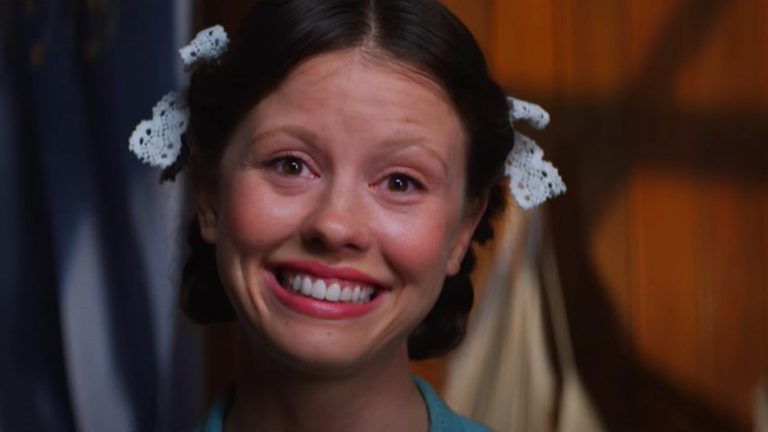Pearl (2022 | USA | 102 minutes | Ti West)
Pearl, the prequel to writer/director Ti West’s well-received shocker X, takes a character’s origin story—the kind usually dispensed as an afterthought in a couple of sentences of exposition or two minutes of black-and-white flashback footage—and turns it into an audacious, grandly operatic standalone experience.
This latest chapter in what’s shaping up to be a franchise winds the clock back to 1918, focusing on X’s antiheroine Pearl (again played by Mia Goth) as a wide-eyed newlywed kid, laser-focused on getting out of her oppressive rural Texas household. Husband Howard serves overseas as a soldier in the thick of World War I, while Pearl cares for her father (Matthew Sunderland), rendered paralytic and near vegetative by the Spanish Flu Pandemic. All the while, she endures the discipline of a harsh, iron-fisted mother (Tandi Wright). Like a lot of people trapped in a horrific domestic scenario, Pearl finds refuge in a darkened theater, where she watches dancers in silent movies and views her own dancing as a ticket out of oblivion.
But Pearl—put mildly—is no suffering saint. A miles-wide malevolent streak courses through her, and the tensions arising between her reach and her grasp in life come to a head in the most harrowing ways possible.
West, who also edited both films, has publicly stated that he intended Pearl to represent a sharp stylistic about-face from X’s visceral ‘70s setting and grindhouse aesthetic (get thee to Josh’s first-rate assessment of the previous film earlier this year for catch-up). He more than makes good on that proclamation right from the get-go, splashing the opening credits with bold, old-school title wipes and a lushly bouncy score from Tyler Bates and Tim Williams. Wonderful as it is, though, the bracing comic incongruity of Pearl frolicking like some bizarro-world Judy Garland on the family farm portends one-joke staleness beyond the initial novelty.
Fortunately, Pearl begins morphing into a more rich and layered film the instant that opening bounds to its conclusion. Returning DOP Eliot Rockett’s photography maintains the intro’s succulent, old-Hollywood enchantment, but the harsh reality of Pearl’s home life sets in quickly. Rockett often shoots West’s interior compositions in tight darkness, magnifying Pearl’s sense of psychological confinement.
There’s an aching inevitability to watching misfortune and wretched familial circumstances amplify the cracks in the sanity of this creepy but strangely sympathetic young woman. And many of the plot developments—Pearl’s encounter with the local movie house’s handsome projectionist (David Corenswet), flashes of vulnerability and sadness from her martinet of a mom—take slight but definite deviations from their expected paths. She may be psychotic, but in a more enlightened, less repressive time Pearl might have had a fighting chance at a normal, happy life.
Lest all this talk of layers and richness lull you into thinking Pearl’s an exercise in indie-drama navel-gazing, be assured (or, depending on your resistance to the genre, warned) that it still possesses the black and bloody heart of a horror movie. Like Norman Bates, West’s antiheroine remains one deranged puppy capable of truly awful things, even as she elicits the most conflicted of sympathies from viewers. Dread and tension thrum through every visually lovely frame. And though they’re artfully shot without a reliance on arterial geysers of blood, the gruesome deaths (most by sharp implement) still deliver a major psychological slap to the chops.
West’s just enough of a classicist to fill this latest effort with easter eggs. In addition to the big emotions and lush photography that echo the melodramas of acknowledged influence Douglas Sirk, those placid wide-open spaces—and how easily they conceal and swallow up all manner of horrific behavior—suggest an even darker variation of the twisted underbelly of Americana perfected by Terrence Malick in Badlands. There’s more than a hint of John Waters’ weld of kitsch and depraved black humor. And horror fans, in particular, will relish Pearl’s nods to Psycho, as well as how the patina of faded dreams represents a direct lineage to movies like Whatever Happened to Baby Jane?.
That said, West’s distinctive fingerprints are all over this, and that proves to be a very good thing. He defiantly leans into a quiet slow burn at times, and as with most of his other films, he allows his main character passages of decidedly indie-movie introspection (not for nothing is West considered one of the Godparents of the Mumblegore variety of low-budget horror). But with Pearl, he’s learned how to integrate all of those personal tics with a master’s sense of confidence and control.
Pearl also serves as a knockout showcase for Mia Goth, who’s turned out to be a superb collaborator. The screenplay she’s co-written with West bears the unmistakable signature of someone who’s fully and truly inhabited this character. It’s inconceivable to imagine her performance centering the movie so perfectly without her significant input.
Two key points in the movie drive her contribution—and the collaborative synergy between her and West—home. The first comes when Pearl role-plays a conversation with her absent husband at the encouragement of her good-natured sister-in-law Mitzy (Emma Jenkins-Purro). The resulting monologue taps into every fiber of joy, nervousness, sadness, thwarted desire, and chilling psychosis that’s brought Pearl to that point.
Exhibit two for the defense comes during the movie’s close. Long past the point of comfort, West keeps the camera focused on Goth’s unearthly, beautiful, incredibly expressive face through several minutes of the closing credits. Rattling off even the most superficial list of the myriad emotions she telegraphs before Rockett’s camera irises out would represent its own form of spoiler. But it’s alternately quintessential Ti West, and the kind of coda that (assuming Oscar voters can withstand the 100-odd transgressive, darkly magical minutes preceding it) can put an actor within striking distance of a little gold statue—the kind of bauble that’d fit nicely into a curio cabinet somewhere in Pearl’s psychologically haunted house.
Pearl opens in theaters today, September 16. Header image courtesy A24.




